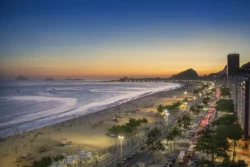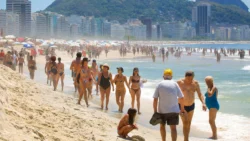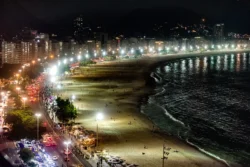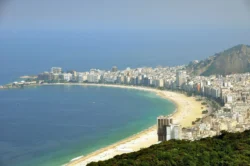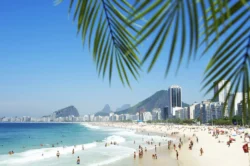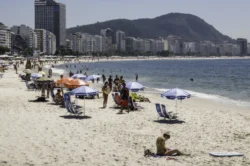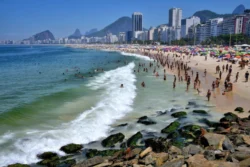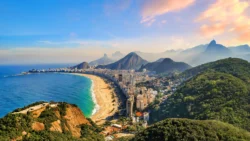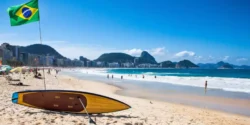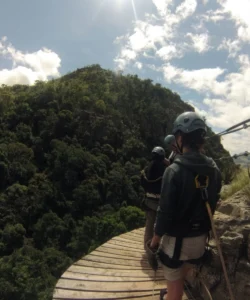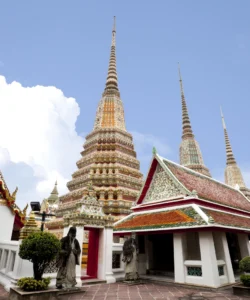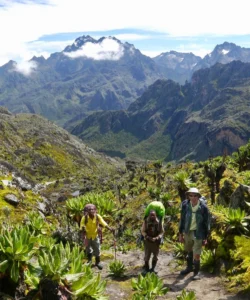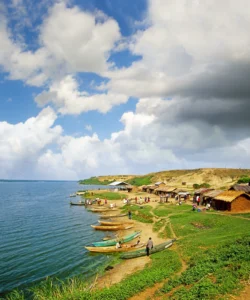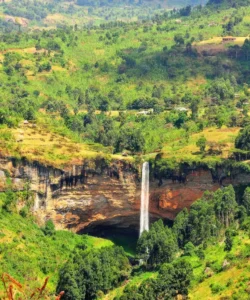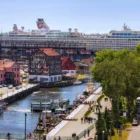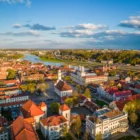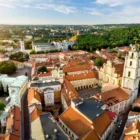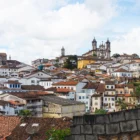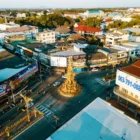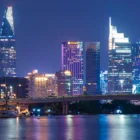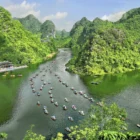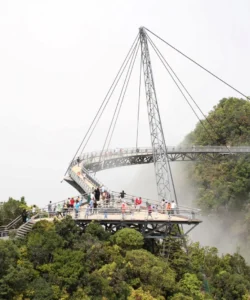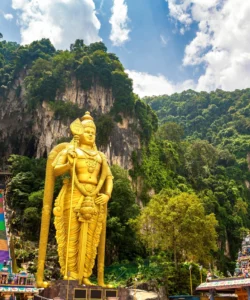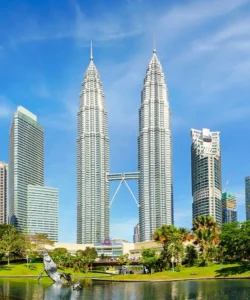Copacabana Beach is arguably the most famous beach in the world, an iconic symbol of Rio de Janeiro, Brazil. Stretching for 4 kilometers (2.5 miles) along a crescent-shaped bay, it’s a vibrant, buzzing stretch of golden sand, framed by towering mountains and the bustling Avenida Atlântica. More than just a beach, Copacabana is a cultural phenomenon, a stage for grand celebrations, a playground for all ages, and a living embodiment of Rio’s energetic “Carioca” spirit.
Name: Copacabana Beach (Praia de Copacabana)
Address: Avenida Atlântica, Rio de Janeiro, Brazil. The beach runs along the entire length of Avenida Atlântica, from Princesa Isabel Avenue at the northern end to Posto Six (Lifeguard Post 6) at the southern end, near Copacabana Fort.
How to get there:
Reaching Copacabana Beach, involves a significant international journey to South America, followed by domestic travel to Rio de Janeiro:
- From Rio de Janeiro to Copacabana Beach:
- By Metro (Subway): The most efficient way. Take Metro Line 1 to Siqueira Campos Station or Cardeal Arcoverde Station. Both stations are within easy walking distance (5-10 minutes) of the beach.
- By Bus: Numerous local bus lines run along Avenida Atlântica and the surrounding streets.
- By Uber/Taxi: Readily available throughout Rio and convenient for direct access to any point along the beach.
- Walking: If you are staying in the Copacabana neighborhood, the beach is the central attraction and easily accessible on foot from most hotels.
Landscape and Architecture:
Copacabana Beach is a natural crescent of sand beautifully integrated with iconic urban and landscape design:
- Crescent-Shaped Golden Sand: The beach itself is a wide, 4-kilometer (2.5-mile) long arc of soft, golden sand, gently sloping into the Atlantic Ocean.
- Iconic Promenade (Calçadão de Copacabana): The most distinctive architectural feature is the famous black-and-white mosaic promenade designed by Roberto Burle Marx (though earlier iterations existed). Its undulating wave pattern, made from Portuguese stones, is instantly recognizable and stretches the entire length of the beach, separating the sand from Avenida Atlântica. This is a masterpiece of urban landscape design.
- Avenida Atlântica: A wide, bustling avenue running parallel to the beach, lined with high-rise hotels, apartment buildings, shops, and restaurants, giving the beach a lively, urban backdrop.
- Sugarloaf Mountain and Leme Rock: To the north, the majestic Sugarloaf Mountain and Leme Rock provide a dramatic natural backdrop, framing the bay.
- Copacabana Fort (Forte de Copacabana): Located at the southern end of the beach (Posto 6), this historic military fort offers panoramic views of the entire Copacabana Bay. It also houses the Army Historical Museum.
- Lifeguard Posts (Postos): Numbered lifeguard posts (Posto 1 to Posto 6) are dotted along the beach, serving as easy meeting points and indicators of different beach “tribes” and activities.
- Beach Kiosks and Vendors: Numerous temporary kiosks and vendors set up on the promenade and sand, selling drinks (like fresh coconuts and caipirinhas), snacks, beachwear, and souvenirs, adding to the informal street-level “architecture” and vibrancy.
- Copacabana Palace Hotel: A grand, historic Art Deco hotel (opened 1923) that stands as an architectural landmark on Avenida Atlântica, symbolizing the golden age of Copacabana.
- Sculptures and Art Installations: Various sculptures and temporary art installations occasionally appear on the promenade or sand, adding artistic flair.
What makes it famous:
Copacabana Beach is famous for:
- Global Iconism: It is simply one of the most recognizable and celebrated beaches in the world, synonymous with Rio de Janeiro and Brazilian culture.
- New Year’s Eve Celebrations (Réveillon): It hosts one of the largest and most spectacular New Year’s Eve celebrations globally, with millions of people gathering to watch a massive fireworks display over the ocean, often dressed in white for good luck.
- Carnival Preparations and Events: During the Carnival season, Copacabana is alive with blocos (street parties) and other vibrant events.
- Lively and Democratic Atmosphere: It is a truly democratic beach, where locals and tourists, rich and poor, mingle freely, enjoying the sun, sea, and vibrant social scene. It’s a place for people-watching and experiencing the “Carioca” way of life.
- Beach Sports Hub: The wide sands are constantly active with beach volleyball, beach soccer, futevôlei (footvolley), and various fitness activities.
- Roberto Burle Marx Promenade: The iconic black-and-white wave-patterned promenade is a work of art in itself, famous worldwide.
- Cultural Reference: Featured prominently in countless songs, films, and literature, contributing to its legendary status.
- Accessibility: Its central location and excellent public transport links make it easily accessible to everyone.
Differences from some other wonders:
Copacabana Beach, while a beach like many others, possesses several unique distinctions:
- Urban Integration with Iconic Promenade: While many cities have urban beaches (e.g., Miami Beach, Bondi Beach), Copacabana’s seamless and incredibly vibrant integration with a dense urban environment and its globally famous, artistic promenade (designed by Burle Marx) is exceptional. The promenade is as iconic as the beach itself.
- Scale of Public Celebration: The sheer scale of public gatherings and celebrations, particularly for New Year’s Eve (millions of people), is unparalleled for a beach worldwide. It transforms into a massive open-air party venue.
- Democratic and Lively Vibe: Compared to other famous beaches that might be more exclusive, tranquil, or purely focused on tourism, Copacabana’s enduring identity is its vibrant, democratic, and constantly active atmosphere where everyday local life unfolds alongside international tourism. It feels authentically Brazilian.
- Framed by Iconic Mountains: Its crescent shape is uniquely framed by the instantly recognizable Sugarloaf Mountain and Leme Rock at its ends, creating a visually stunning and unique geographical context.
- History of Transformation: Its journey from an “inhospitable and unhealthy sandy area” in the 19th century to a global icon through ambitious urban planning (including landfill projects that widened the beach) showcases a remarkable history of urban transformation and reinvention.
In essence, Copacabana Beach is more than just sand and sea; it is a dynamic, living wonder, a cultural stage, and an unparalleled symbol of Rio de Janeiro’s effervescent spirit, where nature’s beauty meets urban vitality in an unforgettable embrace.

